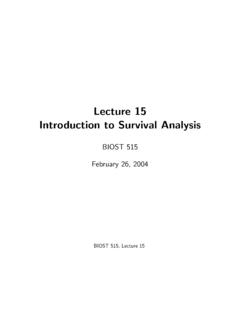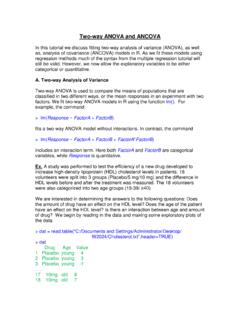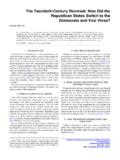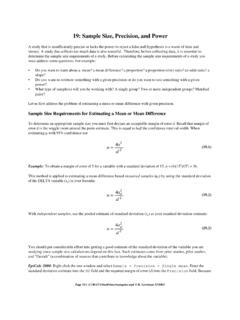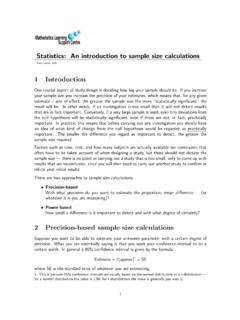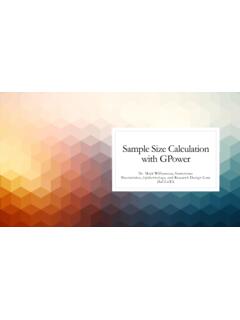Transcription of 13 Determining the Sample Size - Department of Statistics
1 0102030405060708091011121314151617181920 2122232425262728293031323334353637383940 4142434445464748 August 14, 2007 21:30 Wiley/SIDDPage-195 c1313 Determining the Sample SizeHain t we got all the fools in town on our side? and aint that a big enough majority in any town?Mark Twain,Huckleberry FinnNothing comes of ,King BACKGROUNDC linical trials are expensive, whether the cost is counted in money or in human suffering,but they are capable of providing results which are extremely valuable, whether thevalue is measured in drug company profits or successful treatment of future potential value against actual cost is thus an extremely important and deli-cate matter and since, other things being equal, both cost and value increase the morepatients are recruited, Determining the number needed is an important aspect of plan-ning any trial. It is hardly surprising, therefore, that calculating the Sample size isregarded as being an important duty of the medical statistician working in drug develop-ment.
2 This was touched on in Chapter 5 and some related matters were also consideredin Chapter 6. My opinion is that Sample size issues are sometimes over-stressed at theexpense of others in clinical trials. Nevertheless, they are important and this chapterwill contain a longer than usual and also rather more technical background discussionin order to be able to introduce them scientists have to pay some attention to the precision of the instruments withwhich they work: is the assay sensitive enough? is the telescope powerful enough?and so on are questions which have to be addressed. In a clinical trial many factorsaffect precision of the final conclusion: the variability of the basic measurements, thesensitivity of the statistical technique, the size of the effect one is trying to detect, theprobability with which one wishes to detect it if present (power), the risk one is preparedto take in declaring it is present when it is not (the so-called size of the test, significancelevel or type I error rate) and the number of patients recruited.
3 If it be admitted that thevariability of the basic measurements has been controlled as far as is practically possible,that the statistical technique chosen is appropriately sensitive, that the magnitude ofthe effect one is trying to detect is an external given and that a conventional type Ierror rate and power are to be used, then the only factor which is left for the trialist toStatistical Issues in Drug Development/2nd EditionStephen Senn 2007 John Wiley & Sons, Ltd0102030405060708091011121314151617181 9202122232425262728293031323334353637383 9404142434445464748 August 14, 2007 21:30 Wiley/SIDDPage-196 c13196 Determining the Sample Sizemanipulate is the Sample size . Hence, the usual point of view is that the Sample size isthe determined function of variability, statistical method, power and difference practice, however, there is a (usually undesirable) tendency to adjust other factors,in particular the difference sought and sometimes the power, in the light of practical requirements for Sample what follows we shall assume that the Sample size is going to be determined as afunction of the other factors.
4 We shall take the example of a two-arm parallel-group trialcomparing an active treatment with a placebo for which the outcome measure of interestis continuous and will be assumed to be Normally distributed. It is assumed that analysiswill take place using a frequentist approach and via the two independent-samplest-test. Aformula for Sample size determination will be presented. No attempt will be made to deriveit. Instead we shall show that it behaves in an intuitively reasonable shall present an approximate formula for Sample size determination. An exactformula introduces complications which need not concern us. In discussing the samplesize requirements we shall use the following conventions: : the probability of a type I error, given that the null hypothesis is true. : the probability of a type II error, given that the alternative hypothesis is true. : the difference sought. (In most cases one speaks of the clinically relevant difference and this in turn is defined as the difference one would not like to miss.)
5 The ideabehind it is as follows. If a trial ends without concluding that the treatment iseffective, there is a possibility that that treatment willneverbe investigated againand will be lost both to the sponsor and to mankind. If the treatment effect isindeed zero, or very small, this scarcely matters. At some magnitude or other ofthe true treatment effect, we should, however, be disturbed to lose the magnitude is the difference we should not care to miss.) : the presumed standard deviation of the outcome. (The anticipated value of themeasure of the variability of the outcomes from the trial.)n: the number of patients in each arm of the trial. (Thus the total number is 2n.)The first four basic factors above constitute theprimitiveinputs required to determinethe fifth. In the formula for Sample size ,nis a function of and , that is tosay, given the values of these four factors, the value ofnis determined.
6 The functionis, however, rather complicated if expressed in terms of these four primitive inputs andinvolves the solution of two integral equations. These equations may be solved usingstatistical tables (or computer programs) and the formula may be expressed in terms ofthese two solutions. This makes it much more manageable. In order to do this we needto define two further terms as /2: this is the value of the Normal distribution which cuts off an upper tail probabilityof /2. (For example if =0 05 thenZ /2=1 96.)Z : this is the value of the Normal distribution which cuts off an upper tail probabilityof . (For example, if =0 2, thenZ =0 84.)We are now in a position to consider the (approximate) formula for Sample size ,which isn=2 Z /2+Z 2 2/ 2 ( )( This is the formula which is appropriate for a two-sided test of size . See chapter 12for a discussion of the issues.)01020304050607080910111213141516 1718192021222324252627282930313233343536 373839404142434445464748 August 14, 2007 21:30 Wiley/SIDDPage-197 c13 Background197 Power: That which statisticians are always calculating but never is desired to run a placebo-controlled parallel group trial in asthma.
7 The target variableis forced expiratory volume in one second FEV1 . The clinically relevant difference ispresumed to be 200ml and the standard deviation 450ml. A two-sided significancelevel of (or 5%) is to be used and the power should be (or 80%). What shouldthe Sample size be?Solution: We have =200ml =450ml =0 05 so thatZ /2=1 96 and =1 0 8=0 2 andZ =0 84. Substituting in equation ( ) we haven=2 450ml 2 1 96+0 84 2/ 200ml 2=79 38. Hence, about 80 completing patients per treatment arm is useful to note some properties of the formula. First,nis anincreasingfunctionof the standard deviation , which is to say that if the value of is increased so mustnbe. This is as it should be, since if the variability of a trial increases, then, otherthings being equal, we ought to need more patients in order to come to a reasonableconclusion. Second, we may note thatnis adecreasingfunction of :as increasesndecreases.
8 Again this is reasonable, since if we seek a bigger difference we ought to beable to find it with fewer patients. Finally, what is not so immediately obvious is that ifeither or decreasesnwill increase. The technical reason that this is so is that thesmaller the value of , the higher the value ofZ /2and similarly the smaller the valueof , the higher the value ofZ . In common-sense terms this is also reasonable, sinceif we wish to reduce either of the two probabilities of making a mistake, then, otherthings being equal, it would seem reasonable to suppose that we shall have to acquiremore information, which in turn means studying more fact, we can express ( ) as being proportional to the product of two factors,writing it asn=2F1F2. The first factor,F1= Z /2+Z 2depends on the error ratesone is prepared to tolerate and may be referred to asdecision precision. For a trial with10% size and 80% power, this figure is about 6.
9 (This is low decision precision). For1% size and 95% power, it is about 18. (This would be high decision precision.) Thusa range of about 3 to 1 covers the usual values of this factor. The second factor,F2= 2/ 2, is specific to the particular disease and may be referred to asapplicationambiguity. If this factor is high, it indicates that the natural variability from patient topatient is high compared to the sort of treatment effect which is considered is difficult to say what sort of values this might have, since it is quite different fromindication to indication, but a value in excess of 9 would be unusual (this means thestandard deviation is 3 times the clinically relevant difference) and the factor is notusually less than 1. Putting these two together suggests that the typical parallel-grouptrial using continuous outcomes should have somewhere between 2 6 1=12 and2 18 9 325 patients per arm.
10 This is a big range. Hence the importance of decidingwhat is indicated in a given practice there are, of course, many different formulae for Sample size the trial is not a simple parallel-group trial, if there are more than two treatments, ifthe outcomes are not continuous (for example, binary outcomes, or length of survival01020304050607080910111213141516 1718192021222324252627282930313233343536 373839404142434445464748 August 14, 2007 21:30 Wiley/SIDDPage-198 c13198 Determining the Sample Sizeor frequency of events), if prognostic information will be used in analysis, or if the objectis to prove equivalence, different formulae will be needed. It is also usually necessary tomake an allowance for drop-outs. Nevertheless, the general features of the above helpful tutorial on Sample size issues is the paper by Steven Julious inStatisticsin Medicine(Julious, 2004); a classic text is that of Desu and Raghavarao (1990).


